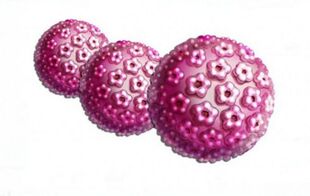
The papilloma virus can live in the human body for a long time and does not appear in any way. It is activated only when the immune system is weak. In most cases, the infection does not pose a particular danger, but some strains, under certain factors, can degenerate into oncological diseases. And this has posed a threat to human life. It is impossible to get rid of pathogenic microorganisms completely. Therefore, it is very important to know how papillomavirus virus is transmitted to reduce the risk of HPV infection.
Virus characteristics and their behavior
Human papillomavirus causes the formation of benign neoplasms on the skin and mucous membranes. They look like papillae, which protrude a few millimeters above the surface. As a rule, such growth occurs when the body's defenses become weak. Usually one lives calmly and does not even think "I can be a carrier or not, " for now. Why papillomas form:
- hypothermia or frequent overheating;
- presence of concomitant disease;
- improper nutrition;
- presence of bad habits;
- stress, depression, overwork;
- deficiency of vitamins, minerals and other nutrients.
90% of the world's population are carriers of the papillomavirus virus. The question immediately arises as to whether human papillomavirus is contagious or not. The answer is yes. No one is 100% insured against infection. Therefore, it is very important to know how you can get HPV (Human Papillomavirus).
How papillomavirus is transmitted
Given the high risk of contracting HPV, the question often arises as to how the infection (human papillomavirus) is transmitted. Knowing the answers to these questions can significantly reduce the risk of infection. Pathogenic microorganisms are transmitted from person to person. This is the most common route of infection. Contact infection method:
- HPV pathogens are sexually transmitted (by having sex). Often, the spread of oncogenic microorganisms occurs in this way. For example, such as HPV 16 and 18. Strain of 16 and 18 types is life threatening, as it can degenerate into oncological diseases.
- Infection contact method. You can infect someone by touching, hugging, kissing. The virus enters the body through damage, microcrats on the skin. Therefore, you should not have close contact with people if you notice warts on their body (if you are in doubt whether it is contagious).
Delivery routes can also be done domestically. How you can get an infection (papilloma) this way:

- through personal hygiene products (towels, wipes, toothbrushes etc. );
- human papillomavirus can be transmitted through clothing (infection occurs through wounds on the skin); Infections
- can occur in public baths, saunas (pathogens can be on the floor, benches, etc. ).
This disease is not inherited. However, newborns can also be infected. How babies can get papilloma:
- during intrauterine development of an infected mother;
- through the birth canal at birth.
Pregnant women need to be very careful not to infect or activate pathogens.After all, their health depends not only on this, but also the life of the baby.
Human papilloma (HPV), how it is transmitted: infections can occur in medical centers, hair salons, beauty salons due to inadequate instrument sterilization. This is very rare, because such institutions, as a rule, meet all hygiene standards, but there are still suitable places.
Infected people may not even realize it. Therefore, it is recommended to undergo a routine diagnostic examination every year. How the infection occurred is now clear. Thanks to this, preventive measures can be taken and infection can be prevented.
Sexual methods
Previously, we learned how you can be infected with benign neoplasms (papillomavirus). It becomes clear that HPV is often transmitted through intimate (sexual) intercourse. Moreover, you can be infected with all kinds of sex (vaginal, oral, anal).Papilloma through intimate (sexual) contact is spread through contact with the mucous membrane, if it is damaged. Moreover, the risk of infection with anal sex is higher, due to more trauma.

Given that during intercourse, the risk of infection increases, the question arises, is it possible to have sex with HPV if one partner has it? Moreover, during sexual intercourse, infection with viral oncogenic strains often occurs.
Sex with HPV is acceptable. But all this time, you should always use a barrier contraceptive (condom). According to statistics, protection helps prevent infection in men and women in 2 out of 3 cases. Without contraception, the risk of infection increases to 90%. If one of the people entering the intimate relationship is infected, it is necessary to undergo regular diagnostic tests to determine the oncogenic pathogen (a healthy partner for the presence of HPV).
However, during sexual intercourse, even with contraceptives, unwanted phenomena can occur. During sexual intercourse, its growth can be injured. As a result, infection or other blood poisoning can occur on the wound. Also, damage to the neoplasm can cause it to degenerate into malignant. Therefore, it turns out thathaving sexual intercourse while treating HPV is not desirable.If you do, be careful. But it is still better to have intercourse only after treatment. Sexual life after papilloma removal is less risky.
It is believed that papillomavirus can be activated through masturbation. Allegedly, this is insufficient intercourse, resulting in hormonal disorders and weakening of the immune system. This opinion is wrong. Masturbation does not affect the body's protective function at all.
For oral sex
HPV can be spread from women to men and vice versa through oral sex. This occurs through micro damage to the skin and mucous membranes. Through oral sex, HPV strains are most often transmitted, which can lead to cancer.
Condoms for oral sex can only reduce the risk of infection if shot work is done. With 90% of cases of cunnilingus, infection is unavoidable.
Is human papillomavirus transmitted from mother to child?
How adults are most often infected with the papillomavirus virus, we know. It is now necessary to understand whether human papillomavirus is transmitted from mother to child, how it occurs and what the risks are for the baby.
In newborns, infection can occur through touching and kissing the mother, if she is a carrier of pathogenic microorganisms. The infection enters the baby's body due to damage to the skin or mucous membranes.
Infection can also occur during fetal development. From an infected woman to her fetus. Also, infections can occur during childbirth. Although rare, it has serious consequences.

Through Kissing and Blood
How human papillomavirus infection is transmitted:
- through saliva;
- through kissing;
- through the blood.
The question immediately arises, if HPV is transmitted through kissing, can you kiss an infected person? The decision is up to you. If you are 100% sure that there is no damage (even microscopic) in your oral cavity, then a kiss is perfectly acceptable. However, this is a rather risky decision. There may be a sore in the mouth that is not felt and you are also unconscious.
The possibility of human papillomavirus virus infection through the blood has not been scientifically proven. There are cases when the infection occurs during transfusion.However, this is not evidence that pathogens can be spread this way.Perhaps the infection in these cases is made through a tool that is not well sterilized.
Household routes
In 85-90% of cases, it is possible to be infected through the household when one of the family members is infected. Pathogenic microorganisms in the home are very often transmitted from parents to children. The child's immunity is not yet strong and therefore the baby is more susceptible to infection. Domestic infections can occur as follows:
Pathogenic microorganisms in the home are very often transmitted from parents to children. The child's immunity is not yet strong and therefore the baby is more susceptible to infection. Domestic infections can occur as follows:
- if there is damage to the skin, infection can occur through the use of bedding, towels, wipes, soap, cosmetics and hugs;
- through saliva, you can be infected while using a plate, toothbrush, kissing with a carrier of the virus;
- while wearing the clothes of an infected person (especially underwear);
- in the home environment, self-infection may occur during shaving, epilation.
Infections in public places are also a common method of pathogen transmission. For example, in the pool, steam bath, sauna. And also with frequent handshakes and friendly hugs.
How not to be infected with papillomavirus
How not to get HPV (human papillomavirus):
- avoid frequent sexual partner exchanges;
- protect themselves during intercourse;
- not to use other people's stuff;
- do not wear other people's clothes;
- avoid visiting public baths, saunas, swimming pools (or at least bring personal towels, interchangeable shoes);
- do not drink or eat food from an infected person;
- approach the choice of cosmetology, clinic, hairdresser carefully (you need to make sure that all sterilization rules are followed in the institution);
- Do not communicate closely with the virus carrier.
If you have papilloma, see your doctor. He or she will carry out the necessary diagnostics, determine the pathogen strain and, if necessary, provide effective treatment.
Does condoms protect
If one partner has HPV, it is necessary to use a condom during sexual intercourse. However, contraceptives are not a 100% guarantee that the infection will not spread. Of course, the pathogenwill not be able to penetrate the condom, but infection can occur in different ways.
Infection can occur with foreplay. Through microcrats on the skin or mouth. In this case, barrier contraceptives will not save.
Methods of treatment
If you are an HPV carrier, the infection may be inactive in your body and not cause problems.To prevent growth in the body, you need to monitor the condition of your immune system.The stronger, the lower the risk of neoplasm formation.
If growth occurs, your doctor may advise you not to take action (provided the papilloma does not cause discomfort and does not experience oncogenic tension) If a decision is made to get rid of the neoplasm, then, as a rule, this is done by conservative methods. If drug treatment does not provide therapeutic results or there is a risk of papilloma degeneration into an oncological disease, surgical intervention is prescribed (if there are no contraindications for this).























